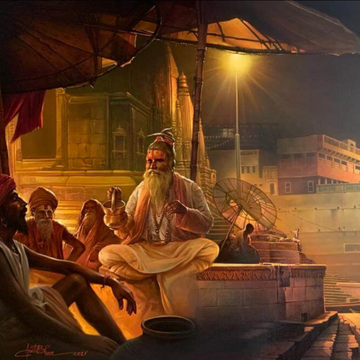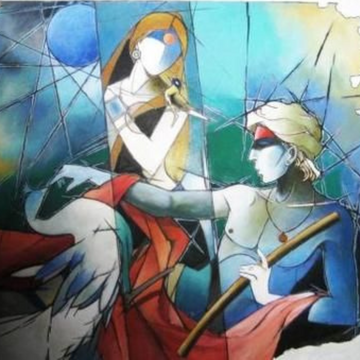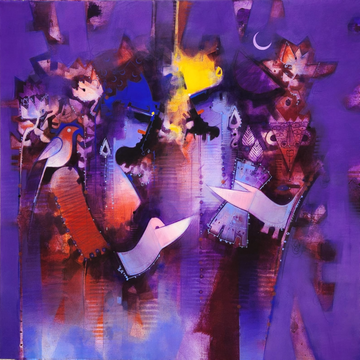6 Best Indian Banaras Artists

Banaras is one of the most spiritual cities in India. A place well known for Ganga Aarti, Banaras is sought after by artists and photographers alike. Most of them, capture the divinity of this holy city in their paintings at different times of the day. Banaras has some of the most ancient temples and most iconic architecture of the country. Apart from these, Banaras is also renowned for its sarees and paan. Every Indian girl dreams of draping a regal Banarasi saree on her wedding day. The bright colours and the gorgeous zari work on the sarees make them one of a kind. Banarasi paan on other hand, contains the essence of a perfect mouth freshener. The sweet sugar, freshness of fennel seeds, spicy cloves and cinnamon, cool menthol, the texture of dry coconut, feels like a burst of flavour in mouth.
Similar to the Banarasi sarees, these artists have a unique perspective towards the blissful beauty of Banaras, each feels like a breath of fresh air, thus reminding us of everything Banaras is known for.

Amit Bahar: Of all the contemporary Banaras paintings, Amit Bahar’s seem the most realist. Amit’s paintings are present in the moment, precise to the details and are weaved out of the basic fabric of the world that is tangible and around us. Realism is an art form, that Amit has definitely mastered. Amit’s paintings emit reality, making the onlookers believes that they are not looking at a painting, but looking out of a window, directly towards the scenic cityscape of the holy city of Varanasi. The fine white mist, raising on the Ganga Ghat, the relic architectural elements of the ancient temples and buildings, the reflection of human beings, buildings and animals in the holy river alike, all create a breathtaking image of the mystical beauty of Varanasi. Through his colours and brushwork, the artist breaths life into his canvas, thus bringing Banaras into existence.

Ananda Das: Ananda Das started his journey of painting by using charcoal as a medium. Growing up in the 70s and 80s, the spectacle of black and white movie posters fascinated Das. He wanted to capture the beauty and simplicity of black and white in his paintings. Ananda likes to capture the spirituality and purity of Banaras in his own way. On a textured background Das first paints the architecture of Ganga Ghat, along with the holy river, in black and white. He then adds red in the roof of the temples and in the worshippers’ clothes to enhance the beauty of his paintings. After experimenting with charcoal and conti, the artist has now graduated to acrylic colours and uses the same medium to create his picturesque Banaras paintings. His paintings seem a little animated and much like a graphic version of the holy city. His colour contrast gives his paintings a sense of tranquility, similar to what one can feel in Varanasi.

Satish Khanna: Life begins in soil and ends in soil, perhaps this is the reason why Satish Khanna uses an earthy colour palette full of yellows, ochers, greens and oranges, to portray his Banaras paintings. His strokes are blunt and his paintings are pure and simple. Satish’s cityscapes would remind one of the images in old graphic novels. The artist not only captures the beauty and serenity of the holy city of Varanasi, but he also illustrates the day to day lives of people visiting the Ganga Ghat. In his own unique way, the artist captures the beauty, serenity and liveliness of Banaras on the canvas. The subtle hues, the flawless brushwork and a fascinating subject, make these paintings absolutely stunning.

Nilesh Bharti: Much like the city itself, Nilesh Bharti’s paintings are as mystifying as Banaras. There is a light mist above the river, that seems to be hazing the temples and buildings around Ganga. Though the artist uses a monochromatic colour palette, the changing hues of the architecture depicts the distance of the building. Nilesh’s paintings have numerous layers to it, each layer fading away with it’s distance to the Ghat. These paintings seem to be a shadow of the real life scene, something that you can experience but not touch.

Paramesh Paul: More than a tourist spot or pilgrimage, Ganga Ghat is an experience. People of different colours, sizes and heights cross paths on these allies, each has a different purpose of the visit. The orange banners, flowers spread across the narrow streets, Shivalinga around almost every corner, the never-ending stairs to the Ghats, chanting of holy verses all combine and create a beautiful experience, one that cannot be felt anywhere else in the world. Paramesh Paul has recreated this beautiful experience on the canvas, where he breathes life into the picturesque scenes with his earthy toned colour palette. The reflection of the people and objects in the waters seems to symbolise the worshippers reflecting on their lives while praying. The shades of fierce reds, bright yellows and the tranquil blues combine together to create a mesmerising painting that seems alive.

Somnath Bothe: The holy city of Banars has different looks at different times of the day. Somnath Bothe captures the beauty of Banaras at different times, in different colours. His paintings are monochromatic, but not all of his paintings are of same colour. Yellows and reds usually signify the mornings and the days, blues and black and whites illustrate the nights. He pairs various colours with black to add a hint of drama in his paintings. Much like many other Banaras artists, the light mist in Somnath’s paintings, steal the show. The mist also signifies rains, a season Somnath is personally fond of. He believes that rains change the mood and the look of a city.












